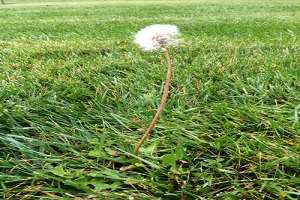By Kevin Frank
While walking through my front yard the other day, there it was, a dandelion puff ball standing tall and proud, almost as if it was sticking its tongue out to really let me know that no, they’re not gone! Summer herbicide applications are very effective at burning down the top-growth of many perennial broadleaf weeds, but as my dandelion was pointing out to me, they’re not gone yet. Many broadleaf weeds including white clover, dandelion and ground ivy are surging in turf right now.

Fall is the ideal time to control broadleaf weeds because unlike the summer when weeds are focusing on top-growth, in the fall weeds are storing energy in their root system and are more susceptible to herbicide applications. So if your once pure turf is now a mixture of weeds and turf, applying a herbicide in early October will make a difference in what you battle next year.
Michigan State University Extension recommends applying the herbicides on a sunny day when rain is not in the forecast for 24 hours. We want the herbicides to dry on the leaf surfaces and not be immediately washed off. You also may need to schedule around tree leaf drop as leaves covering turf will obviously prevent the herbicide from reaching the weeds. There are many different herbicides that could be used including the most common three-way broadleaf weed control mixtures. As with any pesticide application, always make sure to wear the appropriate safety attire and follow all label recommendations.
As many have lamented over the years, the only shortcoming of fall broadleaf weed control is that you really don’t get to watch them die. You generally won’t see the twisting, shriveling and discoloration that often accompany herbicide applications, but next spring the weeds will be gone or at least their numbers will be significantly reduced.
Source: msu.edu